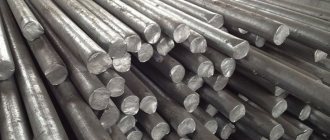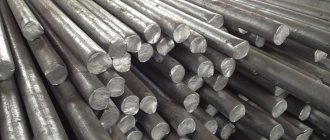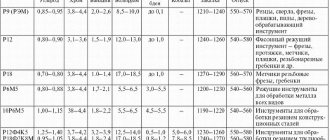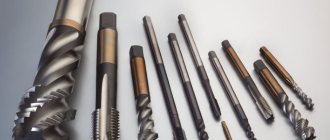R6M5 is a high-speed tool steel of domestic production. It is used to produce metal-cutting tools for drills, machine tools, cutting machines and hand tools.
In the material:
- Main characteristics of the alloy
- What tools are made from R6M5 steel? Drills R6M5
- Taps R6M5
- R6M5 dies
- R6M5 cutters
- R6M5 canvas
- R6M5 cutters
- Other products made from R6M5 steel
Alloy Application
The positive characteristics of this alloy helped to find the use of this steel in household use. Knives are made from it. Moreover, if the product is sharpened correctly, it will be able to cut not only the flesh of an animal, but also a thin metal plate.
Discs made of steel R6M5
The only disadvantage of this product is its sharpening. But, if you know all the tricks of proper sharpening, then this tool will become very useful in everyday life. These products are most often used by hunters and tourists.
Despite the expensive cost, the use of alloy for knives has become very popular in everyday life.
Every man in his house has a power tool, in which drills made of this type of steel are used as auxiliary equipment. The varieties of drills that are made from this R5M6 steel include:
- crown ones, which are used for drywall;
- stepped;
- drills designed for stone, wood or metal.
Not only drills and knives are made from this material. Slotting cutters, hacksaw blades, and countersinks are made from R6M5 steel.
Explanation of the markings of this alloy
The explanation of the R6M5 steel marking is as follows:
- The letter “P” means high-speed or rapid steel, since the marking was based on an abbreviation from the English word “rapid” (read in Russian as rapid), which translated means “fast”. And the number that follows this letter indicates the percentage of tungsten in this alloy. In this case it is equal to 6%, with minor deviations.
- The letter “M” indicates that this alloy contains molybdenum. And the number that follows the letter also shows the amount of its presence in the alloy of this metal as a percentage.
Example of decoding markings
If no additional elements are added to this steel, then its designation ends there. If cobalt is added to the alloy, then it will be designated P6M5K5. Marking "F" - vanadium, "T" - titanium and other additional elements.
According to GOST, R6M5 steel is divided into the following products, which belongs to one of the interstate standards. It describes all the technical requirements related to this brand. Although rolled metal has recently switched to hard alloys, this brand still maintains its leading position in market demand.
https://youtube.com/watch?v=ccSlXrxQTSg
Listed below are some products made from an alloy of these metals and the corresponding GOST for them:
- hot-rolled circles belong to GOST number 2590-88;
- the calibrated rod has GOST 7417-75;
- strips and rods (for the manufacture of these products the steel variety R6M5K5 is used) - GOST 19265-73;
- wheels that have a special finish on the top layer have GOST 14955-77.
Download GOST 2590-88
Download GOST 7417-75
Manganese as an alloying element
Until the 19th century, ordinary steel was used for processing non-ferrous metals and wood. Its cutting characteristics were quite sufficient for this. However, when trying to process steel parts, the tool very quickly heated up, wore out and even became deformed.
The English metallurgist R. Muschette found out through experiments that in order to make the alloy more durable, it is necessary to add an oxidizing agent to it, which will release excess oxygen from it. Mirror cast iron, which contained manganese, began to be added to cast steel. Since it is an alloying element, its percentage should not exceed 0.8%. Thus, R6M5 steel contains from 0.2% to 0.5% manganese.
Peculiarities
Steel grades R6M5 and R18 are used not only in the manufacture of knives, but also in the production of taps, drills, and industrial cutting tools. They are distinguished by their ability to maintain hardness and sharpness when exposed to high temperatures and significant shock loads. The high content of carbon and tungsten in the composition gives steel these characteristics.
Heat treatment
To give knives made from P18 and P6M5 increased strength and wear resistance, the metal is subjected to appropriate heat treatment. It takes place in 2 stages:
- Hardening – heating to a temperature of 1200-1300C. To avoid the formation of cracks, it is carried out gradually. First, the metal is heated to a temperature of 400-500C, then to a temperature of 800-850C. At maximum heating, the workpiece is subjected to heat treatment for a limited time (10-15 seconds for each millimeter of thickness). During hardening, the carbide decomposes, the alloy is saturated with tungsten and carbon.
- Vacation is carried out at a temperature of 550-560C. It is carried out in 2-3 stages, each lasting at least an hour. At the same time, the strength characteristics of the metal increase.
Steel is heated in special salt baths, which consist of barium chloride (78%) and sodium chloride (22%). Magnesium fluoride is used to deoxidize the solution.
Production of cutting tools
After heat treatment of the steel, the production of cutting tools begins. For this purpose, the workpieces, which are previously checked for compliance with GOST requirements, are sent for grinding. Products made from P18 steel are easier to grind, but they also retain their sharpness for a shorter period of time. Knives made from R6M5 alloy can only be sharpened with professional tools and skills, but their sharpening quality is much better. In production, specialized machines are used for grinding workpieces made of steel R18 and R6M5.
Knife Grif steel P18, birch bark handle.
Use in cutting
Knives made of steel P18 and P6M5 are quick-cutting and universal in use. The metal performs well under heat and mechanical stress. It does not lose strength or deform. Manufacturers of knives made from these steel grades conducted experiments during which they successfully coped not only with slicing various food products (meat, bones, cartilage), but also with cutting wood and even metal plates several millimeters thick!
Pros and cons of R6M5 steel
Like any other steel, the P6M5 grade has its advantages and disadvantages. These moments can be seen in finished products - knives. Let's look at the qualities in the table:
pros
- Excellent cutting of hard and heterogeneous materials. Knives made from the steel in question cope well with bone and cartilage tissue;
- the products are quite durable and resistant to heavy loads, at the same time quite easy to care for;
- the light weight of the blades allows you to quickly change the direction of the cut in the kitchen, increasing or decreasing the cutting;
- slight contact with an open flame will not affect the characteristics of the blade in any way;
- small particles of the processed material are not able to penetrate the steel structure. Such knives can be used for cutting animal carcasses;
- the steel is resistant to alkalis and acids, which makes the knives suitable for use in construction activities;
- there is no need to use special products to clean the blade;
- Due to the structure of the crystal lattice, the products can be used in conditions of electromagnetic and electric fields.
Minuses
- the low chromium content makes the knives not resistant to corrosion;
- high cutting ability of the knife, requires careful handling, it is easy to get hurt;
- The blade is sharpened on special sharpening machines;
- the product may become dull if not used for a long time;
- long-term exposure to negative temperatures on the blade negatively affects the characteristics;
- the blade does not withstand lateral loads well and is easy to break.
Application of high speed steels
Cobalt and vanadium high-speed steels are used for processing structural steels at high cutting conditions, as well as heat-resistant, stainless and high-strength steels.
Tools made from cobalt steels are used for machining heat-resistant and corrosion-resistant steels, as well as other difficult-to-cut alloys, and are suitable for use in conditions of insufficient cooling, interrupted cutting and vibration. The area of application of high-speed vanadium steels is the manufacture of tools intended for finishing of hard-to-cut metals (reamers, broaches, etc.)
High speed steel P18
The alloy contains 18% tungsten and is relatively easy to grind. The hardness of the tool after heat treatment is HRC 62-65, red hardness 600ºС. The presence of an excess carbide phase gives the steel a fine-grained structure, increases the wear resistance of products, and reduces sensitivity to overheating. Quick cutter P18 is used for the manufacture of cutters, shaver, drills, cutters, taps, reamers. The main disadvantage of tungsten steels is significant carbide heterogeneity, which becomes critical in products with large cross-sections. Carbide heterogeneity reduces tool life and leads to chipping of cutting edges.
High-speed steel R6M5
High-speed steels with a high tungsten content have recently been replaced by complex alloys in which tungsten is partially replaced by molybdenum. In this way, the carbide heterogeneity of the metal is noticeably reduced, which increases the strength of the tool and its resistance to impact loads. Among the typical representatives of the group of tungsten-molybdenum steels are R6M5 and R6M3 steels.
The technological qualities of R6M5 steel are close to those of R18 steel, that is, these alloys are interchangeable. In some cases, the use of R5M6 steel is more preferable, in particular, in the manufacture of large-sized tools. Due to its high strength, manufacturability and durability, R6M5 steel is currently the most popular of the high-productivity steels.
The range of high-speed steel includes:
- Circle;
- Square:
- Sheet;
- Band.
High-speed steel wheels are used for the manufacture of drills, drills, saws, taps and other cutting tools. Squares are used less frequently, mainly for the production of turning tools and knives for electric planers.
Tungsten deficiency
Of course, in the 1860s, when many elements were in full abundance, steel containing tungsten was considered the strongest. Over time, this element in nature becomes less and less, and its price increases.
From an economic point of view, adding large amounts of W to steel became impractical. For this reason, P6M5 steel is much more popular than P18. Looking at their chemical composition, you can see that the tungsten content in P18 is 17-18.5%, while in the tungsten-molybdenum alloy it is up to 6.5% maximum. In addition, Samokal contains up to 0.25% copper and up to 5.3% molybdenum.
Characteristics and grades of HSS steel
High-speed varieties are high-carbon steels. Some brands contain a fairly large amount of tungsten. In addition, they may contain cobalt and molybdenum. If we talk about the hardness of alloys, the indicator is most often in the range of 62–64 units of the HRC scale. Comparing products made from high-speed steel and carbide, it is worth noting that the first option is distinguished by a fairly affordable price and increased wear resistance.
Recently, it has been customary to distinguish 3 main groups of HSS steel, each of which has its own characteristics:
- High tungsten content (T)
- High Molybdenum (M)
- High alloy
Tungsten steels
Not the most popular variety. This is due to the fact that tungsten is quite rare and expensive. The most common grades of tungsten steel are T1 and T15. The second contains cobalt and vanadium, therefore they are suitable for the production of accessories that have increased requirements for strength and resistance to high temperatures.
Chemical composition of tungsten HSS steels
| Type | Analogue | C | Mn | Si | Cr | V | W | Mo | Co | Ni |
| T1 | P18 | 0,75 | — | — | 4,00 | 1,00 | 18,00 | — | — | — |
| T2 | R18F2 | 0,80 | — | — | 4,00 | 2,00 | 18,00 | — | — | — |
| T4 | R18K5F2 | 0,75 | — | — | 4,00 | 1,00 | 18,00 | — | 5,00 | — |
| T5 | 0,80 | — | — | 4,00 | 2,00 | 18,00 | — | 8,00 | — | |
| T6 | 0,80 | — | — | 4,50 | 1,50 | 20,00 | — | 12,00 | — | |
| T8 | 0,75 | — | — | 4,00 | 2,00 | 14,00 | — | 5,00 | — | |
| T15 | R12K5F5 | 1,50 | — | — | 4,00 | 5,00 | 12,00 | — | 5,00 | — |
Molybdenum and high alloy steels
They are very widespread. May contain cobalt and tungsten. Those brands whose formula includes carbon and vanadium are characterized by increased strength and wear resistance, and resistance to abrasives. Alloys, starting with M41, are used to produce devices that retain their characteristics even when super heated. To create equipment designed for work at low temperatures, steels with molybdenum are also used, but they are subject to additional processing.
Chemical composition of molybdenum HSS steels
| Type | Analogue | C | Mn | Si | Cr | V | W | Mo | Co | Ni |
| M1 | 0,80 | — | — | 4,00 | 1,00 | 1,50 | 8,00 | — | — | |
| M2 | P6M5 | 0,85 | — | — | 4,00 | 2,00 | 6,00 | 5,00 | — | — |
| M3 | P6M5Ф3 | 1,20 | — | — | 4,00 | 3,00 | 6,00 | 5,00 | — | — |
| M4 | 1,30 | — | — | 4,00 | 4,00 | 5,50 | 4,50 | — | — | |
| M6 | 0,80 | — | — | 4,00 | 2,00 | 4,00 | 5,00 | — | — | |
| M7 | 1,00 | — | — | 4,00 | 2,00 | 1,75 | 8,75 | — | — | |
| M10 | 0,85–1,00 | — | — | 4,00 | 2,00 | — | 8,00 | — | — | |
| M30 | 0,80 | — | — | 4,00 | 1,25 | 2,00 | 8,00 | — | — | |
| M33 | 0,90 | — | — | 4,00 | 1,15 | 1,50 | 9,50 | — | — | |
| M34 | 0,90 | — | — | 4,00 | 2,00 | 2,00 | 8,00 | — | — | |
| M35 | R6M5K5 | 0,82–0,88 | 0,15–0,40 | 0,20–0,45 | 3,75–4,50 | 1,75–2,20 | 5,5–6,75 | 5,00 | 4,5–5,5 | up to 0.30 |
| M36 | 0,80 | — | — | 4,00 | 2,00 | 6,00 | 5,00 | — | — |
Chemical composition of high alloy HSS steels
| Type | Analogue | C | Mn | Si | Cr | V | W | Mo | Co | Ni |
| M41 | R6M3K5F2 | 1,10 | — | — | 4,25 | 2,00 | 6,75 | 3,75 | 5,00 | — |
| M42 | 1,10 | — | — | 3,75 | 1,15 | 1,50 | 9,50 | 8,00 | — | |
| M43 | 1,20 | — | — | 3,75 | 1,60 | 2,75 | 8,00 | 8,25 | — | |
| M44 | 1,15 | — | — | 4,25 | 2,00 | 5,25 | 6,25 | 12,00 | — | |
| M46 | 1,25 | — | — | 4,00 | 3,20 | 2,00 | 8,25 | 8,25 | — | |
| M47 | R2AM9K5 | 1,10 | — | — | 3,75 | 1,25 | 1,50 | 9,50 | 5,00 | — |
| M48 | 1,42–1,52 | 0,15–0,40 | 0,15–0,40 | 3,50–4,00 | 2,75–3,25 | 9,50–10,5 | 0,15–0,40 | 8,00–10,0 | up to 0.30 | |
| M50 | 0,78–0,88 | 0,15–0,45 | 0,20–0,60 | 3,75–4,50 | 0,80–1,25 | up to 0.10 | 3,90–4,75 | — | up to 0.30 | |
| M52 | 0,85–0,95 | 0,15–0,45 | 0,20–0,60 | 3,50–4,30 | 1,65–2,25 | 0,75–1,50 | 4,00–4,90 | — | up to 0.30 | |
| M62 | 1,25–1,35 | 0,15–0,40 | 0,15–0,40 | 3,50–4,00 | 1,80–2,00 | 5,75–6,50 | 10,0–11,0 | — | up to 0.30 |
When selecting products made from molybdenum material, it is worth considering the features of a particular brand:
- M1. Ideal for releasing drills. They are flexible and shock resistant. But they cannot boast of significant red fastness.
- M2. One of the most popular materials. Often used for the production of tools for various purposes. The product is suitable for intensive work using machines. The main feature of such a tool is its exceptional red resistance, which means the cutting element will retain its qualities for a long time. Our catalog presents drills of the HSS-STANDARD series made of this alloy
- M7. Ideal for producing large drills designed for drilling materials of increased hardness or thick sheets.
- M35. It has increased red fastness due to the increased amount of cobalt in the formula. But it has low resistance to shock loads.
- M42. Contains a large amount of cobalt, therefore it has excellent red fastness. In addition, it is extremely resistant to abrasion. Ideal for making accessories for working with particularly hard or even viscous materials. Core cutters made from this material are presented in the HSS-CO 8 line of drills
- M50. Often used to produce drills that come with portable equipment.
Chemical composition
The chemical composition of R6M5 includes, in addition to the carbon and molybdenum listed above, the following components:
- carbon (C) 0.82 - 0.90%;
- manganese (Mn) 0.20 - 0.50%;
- chromium (Cr) 3.8 - 4.4%;
- silicon (Si) 0.20 - 0.50%;
- molybdenum (Mo) 4.8 - 5.3%;
- vanadium (V) 1.7 - 2.1%;
- cobalt (Co) 0.5%;
- nickel (Ni) 0.4%;
- phosphorus (P) 0.03%;
- sulfur (S) 0.025%;
- tungsten (W) 5.5 - 6.5%.
An alloy with cobalt additives has been used since the beginning of the twentieth century. It is used to produce devices for cutting acid-resistant metals that are resistant to high temperatures. Processing such metals with devices from a different brand requires additional costs. This steel is characterized by high hardness and heat resistance.
Manufacturing and processing of high-speed steels
High-speed steels are produced both by the classical method (casting steel into ingots, rolling and forging) and by powder metallurgy methods (spraying a jet of liquid steel with nitrogen). The quality of high-speed steel is largely determined by the degree of its forging. When insufficient forging of steel produced by the classical method, carbide segregation is observed.
A common mistake when making high-speed steels is to treat them as “self-hardening steels.” That is, it is enough to heat the steel and cool it in air, and you can get a hard, wear-resistant material. This approach absolutely does not take into account the features of high-alloy tool steels.
Before hardening, high-speed steels must be annealed. In poorly annealed steels, a special type of defect is observed: naphthalene fracture, when, despite the normal hardness of the steel, it has increased brittleness.
A competent choice of quenching temperature ensures maximum solubility of alloying additives in α-iron, but does not lead to grain growth.
After quenching, 25–30% retained austenite remains in the steel. In addition to reducing the hardness of the tool, retained austenite leads to a decrease in the thermal conductivity of steel, which is extremely undesirable for working conditions with intense heating of the cutting edge. Reducing the amount of retained austenite is achieved in two ways: by cold treating the steel or by repeated tempering. When processing steel by cold, it is cooled to −80…−70 °C, then tempered. When tempering multiple times, the “heating-holding-cooling” cycle is carried out 2-3 times. In both cases, a significant reduction in the amount of retained austenite is achieved, but it is not possible to completely get rid of it.
Principles of alloying high-speed steels
The high hardness of martensite is explained by the dissolution of carbon in α-iron. It is known that when tempering from martensite in carbon steel, tiny particles of carbide are released. While the released carbides are still in the finest dispersed dispersion (that is, at the first stage of precipitation when tempered to 200 °C), the hardness does not noticeably decrease. But if the tempering temperature is raised above 200 °C, carbide precipitation increases and the hardness decreases.
In order for steel to consistently maintain its hardness when heated, it must be alloyed with elements that would complicate the process of coagulation of carbides. If you introduce some carbide-forming element into steel in such an amount that it forms a special carbide, then the red-hardness increases abruptly. This is due to the fact that the special carbide precipitates from martensite and coagulates at higher temperatures than iron carbide, since this requires not only the diffusion of carbon, but also the diffusion of alloying elements. Almost noticeable coagulation of special carbides of chromium, tungsten, molybdenum, vanadium occurs at temperatures above 500 °C.
Red resistance is created by alloying steel with carbide-forming elements (tungsten, molybdenum, chromium, vanadium) in such an amount that they bind almost all the carbon into special carbides, and these carbides go into solution during quenching. Despite the strong difference in the general chemical composition, the composition of the solid solution is very similar in all steels, the atomic sum W + Mo + V, which determines the red resistance, is approximately 4% (atomic), hence the red resistance and cutting properties of different grades of high-speed steels are similar. High-speed steel containing cobalt has superior cutting properties to other steels (it increases red-hardness), but cobalt is a very expensive element.
Sharp knife made from quick cutter R6M5
Attention!!!
This homemade product is posted for informational purposes only. The creation and use as a bladed weapon is prohibited; according to Article 223.4 of the Criminal Code of the Russian Federation, it is punishable by imprisonment for up to two years!
This steel is quite durable, it is enough for long-term heavy work. This steel does not lose its strength even at high temperature loads. The only drawback of this metal is that it is very difficult to harden it with your own hands. Hardening requires repeated heating, tempering, and special chemicals, such as saltpeter, for cooling. But if you process the metal carefully, without overheating, then you won’t need to harden it. So, let's look in more detail at how to make a knife from R6M5 steel.
Materials and tools used by the author:
List of materials:
— R6M5 steel (hacksaw blade); - a piece of wood for the handle; - epoxy adhesive; - a piece of brass for the handle; - oil or varnish to impregnate the handle.
List of tools:
- Bulgarian; - vice; - grinder; — orbital sander or machine; - drill; — a clamp (the author’s homemade one is made from wood); - marker; - sandpaper; - jigsaw.
Knife making process:
Step one. Cutting out the main profile
First we need to figure out what our knife will look like. Draw the profile of the knife on the workpiece using a marker. Well, then you can start cutting. We cut the workpiece using a grinder, but when cutting P6M5 there is one nuance. This steel is quite brittle and breaks when subjected to strong bending. All we need to do is make small cuts with a grinder in the areas that we need to remove. Well, then we break them off with pliers, like glass.
Step two.
Finalizing the profile Step three.
Bevels and sanding The final finishing is done by hand using fine sandpaper soaked in water. Well, at the very end, the blade can be polished on a machine using GOI paste or another paste.
Step four. Brass insert
There is a brass insert at the front of the handle. We select the desired piece of brass and drill a series of holes in it. Then these holes are bored out with a flat file so that the shank of the blade can fit in. At the same step, you can immediately give the workpiece an oval shape on the sharpener. The author immediately polished the part on the machine, since this would be much more difficult to do later.
Step five. Blank for handle
Step six. Final modification of the knife
When the glue dries, we take out our knife and draw the desired handle profile with a pencil. Next, we cut off the excess with a jigsaw; the fastest way to do this is with a jigsaw. We grind the handle to obtain the desired profile, rough processing can be done on a sharpening machine or grinder. Well, we carry out finer processing manually using sandpaper. Making the handle absolutely smooth.
I hope you liked the project and found useful information for yourself. Good luck and creative inspiration if you want to repeat the homemade product. Don't forget to share your ideas and developments with us.
Attention!!!
This homemade product is posted for informational purposes only. The creation and use as a bladed weapon is prohibited; according to Article 223.4 of the Criminal Code of the Russian Federation, it is punishable by imprisonment for up to two years!
Source
Become the author of the site, publish your own articles, descriptions of homemade products and pay for the text. Read more here.
Characteristics of high-speed steels
Hot hardness
At normal temperatures, the hardness of carbon steel is even slightly higher than the hardness of high-speed steel. However, during operation of the cutting tool, intense heat is generated. In this case, up to 80% of the released heat is spent on heating the instrument. Due to an increase in the temperature of the cutting edge, the tool material begins to temper and its hardness decreases.
After heating to 200 °C, the hardness of carbon steel begins to rapidly decrease. For this steel, a cutting mode in which the tool would heat up above 200 °C is unacceptable. High-speed steel retains its high hardness when heated to 500–600 °C. High speed steel tools are more productive than carbon steel tools.
Red fastness
If hot hardness characterizes what temperature steel can withstand, then red hardness characterizes how long the steel will withstand such a temperature. That is, how long will quenched and tempered steel resist softening when heated.
There are several characteristics of red fastness. Let's give two of them.
The first characteristic shows what hardness the steel will have after tempering at a certain temperature for a given time.
The second way to characterize red hardness is based on the fact that the intensity of the decrease in hot hardness can be measured not only at high temperature, but also at room temperature, since the hardness decrease curves at high temperature and room temperature are equidistant, and measuring hardness at room temperature, of course, is much easier than at high. Experiments have shown that cutting properties are lost at a hardness of 50 HRC at cutting temperature, which corresponds to approximately 58 HRC at room temperature. Hence, red hardness is characterized by a tempering temperature at which in 4 hours the hardness decreases to 58 HRC (designation K4р58). Characteristics of heat resistance of carbon and red resistance of high-speed tool steels
| steel grade | Temperature, °C | Exposure time, hour | Hardness, HRCе |
| U7, U8, U10, U12 | 150—160 | 1 | 63 |
| P9 | 580 | 4 | |
| U7, U8, U10, U12 | 200—220 | 1 | 59 |
| R6M5K5, R9, R9M4K8, R18 | 620—630 | 4 |
Fracture Resistance
In addition to “hot” properties, high mechanical properties are also required from the cutting tool material; This means resistance to brittle fracture, since at high hardness (more than 60 HRC) fracture always occurs by a brittle mechanism. The strength of such high-hard materials is usually defined as the resistance to fracture during bending of prismatic, uncut specimens under static (slow) and dynamic (fast) loading. The higher the strength, the greater the force the working part of the tool can withstand, the greater the feed and depth of cut that can be applied, and this increases the productivity of the cutting process.
Chemical composition of high-speed steels
Chemical composition of some high-speed steels
| steel grade | C | Cr | W | Mo | V | Co |
| Р0М2Ф3 | 1,10—1,25 | 3,8—4,6 | — | 2,3—2,9 | 2,6—3,3 | — |
| R6M5 | 0,82—0,90 | 3,8—4,4 | 5,5—6,5 | 4,8—5,3 | 1,7—2,1 | < 0,50 |
| R6M5F2K8 | 0,95—1,05 | 3,8—4,4 | 5,5—6,6 | 4,6—5,2 | 1,8—2,4 | 7,5—8,5 |
| P9 | 0,85—0,95 | 3,8—4,4 | 8,5—10,0 | < 1,0 | 2,0—2,6 | — |
| P18 | 0,73—0,83 | 3,8—4,4 | 17,0—18,5 | < 1,0 | 1,0—1,4 | < 0,50 |
Difficulties in hardening high-speed steel
Heat treatment of P6M5 contains a number of specific features associated with the characteristics of this brand, as well as a long heating time for hardening. To reach 1230 degrees Celsius (hardening temperature according to GOST), 25 percent more working time is spent than for a similar grade P18. First, a vacation period is made at 200 and 300 degrees for an hour. Further processing is carried out in 3 stages:
- 690 degrees -3 minutes;
- 860 - also 3 minutes;
- 1230 - 1.5 minutes.
Then the steel is cooled. In further processing, a three-time vacation period at 560 degrees for 1.5 hours is used. During tempering periods, the alloy is supplemented with alloying additives that form carbides, which increases the strength of the final metal. Previous annealing of steel helps eliminate high brittleness with a high strength index.
Types of HSS steels
HSS steels come in three categories:
- tungsten (T1-T15);
- molybdenum (M1-M36);
- highly alloyed (M41-M62).
The most commonly used grade is T1 and the alloy with the addition of cobalt and vanadium T15. T15 steel is used to produce tools that are needed to work at high temperatures and increased wear.
Tungsten steels
Not the most popular variety. This is due to the fact that tungsten is quite rare and expensive. The most common grades of tungsten steel are T1 and T15. The second contains cobalt and vanadium, therefore they are suitable for the production of accessories that have increased requirements for strength and resistance to high temperatures.
Molybdenum HSS drills
The main alloying component of steels in this group is molybdenum. Also in different quantities may contain:
- tungsten,
- cobalt;
- vanadium;
- carbon;
- and other components.
The most widely used are HSS drills made from the following types of molybdenum high-speed steels.
- M1. General purpose tools are produced from this grade of steel (8% molybdenum). These HSS drills are highly flexible and resistant to impact loads. Red fastness is lower than that of analogues.
- M2 (domestic equivalent - P6M5). This is the most common material for the production of HSS drills. The alloy contains 6% tungsten and 5% molybdenum. It has balanced strength, hardness and heat resistance.
- M3 (domestic equivalent - R6M5F3). This alloy also contains 3% vanadium. HSS drills made from this steel have lower abrasive wear.
- M7. The main alloying components are molybdenum (8.75%), vanadium (2%) and tungsten (1.75%). Drills made from this HSS steel are used for drilling hard and thick sheet metals.
- M35 (domestic equivalent - R6M5K5). In addition to tungsten, molybdenum and vanadium, this alloy contains cobalt (5%), as well as small amounts of manganese, silicon and nickel. The advantages of this material are good toughness, excellent grindability, heat and wear resistance. HSS drills made from this alloy are used when processing workpieces made of improved alloy and stainless steels under conditions of increased heating of the cutting edge.
High alloy HSS drills
To produce high-alloy HSS drills (having high impact strength and operating in cold conditions), molybdenum group alloys are used, which are subjected to special heat treatment.
- M47 (domestic analogue - R2AM9K5). Contains large quantities of molybdenum (9%) and cobalt (4.7–5.2%). The alloy has an increased tendency to decarburization and overheating during quenching. Sandability is low. HSS drills made from this alloy are used for machining workpieces made of improved alloy and stainless steels.
- M42. Contains a large amount of cobalt and molybdenum (8 and 9.5%, respectively). HSS drills made from this alloy are characterized by increased red hardness and abrasion resistance. Such tools are used when processing viscous and complex metals.
This is interesting: Design, operating principle and circuit diagram of a welding inverter. Types and classifications
Designation P6M5
The definition of steel depends on how it is made, what alloying elements it contains and how much carbon it contains. Different types have their own designations. If, for example, the alloy does not contain alloying elements, then it is designated “St” and next to it is a number that shows the average carbon content in the steel (St20, St45).
In low-alloy alloys, the percentage of carbon comes first, and then the letters indicating the chemical elements (10ХСНД, 20ХН4ФА). If, as in the example, there are no numbers next to them, it means that the content of each of them does not exceed 1%. The letter “P” in the grade of the alloy means that it is high-speed (rapid).
Following it is a number - this is the percentage of tungsten (P9, P18), and then the letters and numbers are the alloying elements and their percentage. It follows from this that high-speed steel R6M5 contains up to 6% tungsten and up to 5% molybdenum.
Where are high speed steels used?
The scope of wear-resistant metal depends on the composition that determines its working properties. Basically, this is a tool that has high demands on strength, heat resistance, and long service life.
- Production of drills, cutters, cutters, taps;
- Manufacturing cutting edges for tools, which in some cases can be removable;
- Parts for metalworking machines and equipment;
- Manufacturing of tools used for finishing hard-to-cut metal products.
Experts give the following recommendations on the use of these metal grades:
- Tungsten-molybdenum compounds are suitable for tools intended for roughing products, manufacturing cutters, broaches and shaver.
- Cobalt compounds are used for processing heat-resistant and corrosion-resistant products in difficult conditions.
- Vanadium alloys are used for finishing materials.
- The P9 grade is used to create equipment elements that are not subject to excessive load.
- Grade P18 is suitable for tools with complex shapes and shaped products with increased wear resistance requirements.
The range of metal products is represented by square, circle, strip, and sheet metal. Most often, cutting tools are made from a circle. Square steel is used for the production of electric planers, knives, and turning tools. If you have doubts about the correct choice of a suitable alloy, it is better to contact specialists. Specialized companies will be able to select high-quality rental products with the required performance characteristics.
Metal cost
It is relatively easy to purchase this steel in finished form, but the cost is quite high. For example, a tool wheel, depending on the thickness, costs from 600 to 1350 rubles per kilogram. The instrumental strip is sold for 620 rubles.
Prices can vary over a fairly wide range. But the high cost of such steel allows it to be sold at a fairly high price in the future. The secondary price for products made of high-speed steel is higher than analogues of standard metal grades. Structures that have expired can be used as business scrap with increased value.
Decoding - what the marking symbols mean
Elements of equipment and devices have a high strength index, the material has excellent viscosity. Steel ensures long-term performance, both in product components and in blades or finished tools.
Such markings are a legacy of the Soviet era:
- The letter “P” is an indicator of high-speed steels. The expression comes from the translation of the English “rapid” - “swift”.
- The sign after “P” indicates the presence of tungsten in the composition as a percentage. For this particular metal it is in the range of 6% with minor deviations.
- This is followed by the letter “M”, indicating the presence of molybdenum in the stamp. The next indicator is the percentage of presence of the element in the total mass.
- In addition to M, high-speed steels can include the following designations in their markings: “K” - cobalt, “T” - titanium, “F” - vanadium, “C” - zirconium.
Considering the designation “P6M5”, decoding can also include other letters. If the steel was smelted by electroslag remelting, an addition appears in the form of “Ш” (Р6М5-Ш). With the introduction of the latest technologies into the production process, the following wording now appears - P6AM5. This means adding nitrogen to the overall composition.









